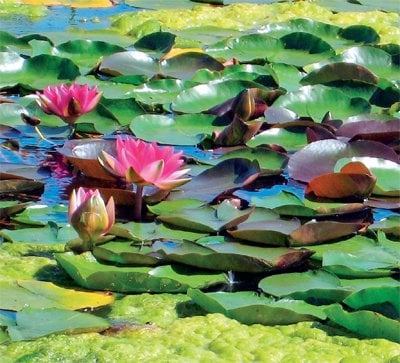Phuket Gardening – still waters run deep

PHUKET: Asians prize water features in their gardens – from the humble pot in the front yard with its mandatory water lily and darting swordtail fish, to the blue fiberglass fish pond with a row of pebbles embedded in its rim.
If you’re lucky, you may have a natural pond or klong (canal) within the bounds of your property. Unarguably, water adds another dimension to your garden, both as an eye-catching feature and because it allows the cultivation of plants that otherwise would not be possible.
The simplest version is a large ceramic pot, usually set on a matching ceramic pedestal.
Or you can use a terracotta pot, but it must be glazed. Natural terracotta is porous, so the water will seep out. Furthermore, natural terracotta is not healthy for fish. It used to be difficult to find pots without drainage holes but now manufacturers have wised-up to the demand for watertight versions.
A third alternative is perhaps the most attractive option: a do-it-yourself pond.
Select your location – next to a wall is good – and level a suitable-sized rectangular plot of ground. It can be a shallow trench, or at ground level.
Then, use large, flattish briquettes to create a supporting wall about twelve or fifteen inches high, add a light layer of sand to the bottom to ensure that there are no sharp protruding stones, and then line the entire construction, including the flat bricks, with a sheet of heavy-duty, black plastic. Place a final row of bricks on top of the plastic liner, to hold it in place, then trim off the surplus plastic.
Add a ceramic vase to the middle of your new feature. Some of them have a projecting metal nozzle which you can connect to a pump, preferably a submersible one, and – presto, you have a fountain with water cascading down the sides of the vase. The whole process is well illustrated in a CD entitled Bali Garden (price 89 baht) obtainable from bookshops such as Sengho in Phuket Town.
Having a small pump to oxygenate the water is especially desirable if you want small fish to keep the plants company. Submersible pumps are best, but there are cheaper alternatives. The hardiest fish are guppies and swordtails. There are many others, but these are good starters. They are pretty, lively and will certainly breed. Ensure you let everything in your new pond settle down for a few days before introducing them to their new home.
As for plants, the list is extensive. Everyone’s favorite is the water lily (nymphea), now available in hybrids so exotic that they are not yet featured in books. At the recent Saphan Hin plant market in Phuket Town, there were huge double blooms on sale in deep Prussian blue, and some with golden centers that are absolutely gorgeous.
Nympheas are sold either in plastic pots which you can submerge straightaway in the water, or as trimmed roots. Whatever style you choose, ensure that the old leaves are removed, and if you buy a root remember to purchase a few bags of the special mud required for water lilies and lotuses.
Finally and most importantly, ensure that the crown of the root is visible above the surrounding mud. Otherwise, the lily will die from suffocation.
Some plants, such as elodea or Canadian pond weed barely feature as visible attractions but are excellent as oxygenators for fish, especially if you don’t have a pump. Other water plants, such as the lotus, look superb in tall vases but are less suited to the average water feature.
Tip of the week
In a previous column I suggested that you suspend your potted orchid from a structure such as a trellis or tree. In garden centers, orchids are normally sold in porous plastic pots with wires for hanging. There are also wooden baskets.
I think the husk of a coconut, stapled together to form a natural bowl, is best, as it most closely simulates conditions in the wild. As an alternative, you can anchor your orchid vertically to the trunk of a tree – after the manner of a stag-horn fern. Loosely packed coir (coconut fiber) is normally used for potting, though you can use compost, or even charcoal.
Some varieties such as cattleya, dendrobium and oncidium only need water during their growing period; others such as cymbidium, vanda, and phalaenopsis should be kept slightly moist. Never water the leaves, and you should feed with a liquid orchid fertilizer as prescribed.
Phuket Gardening is Phuket Gazette columnist Patrick Campbell’s feature of all things flora.
If you have a garden that you would like featured on this page, please email Patrick by clicking here.
Keep checking our online Phuket Lifestyle pages for regular gardening features and tips.
— Patrick Campbell
Latest Thailand News
Follow The Thaiger on Google News:


























